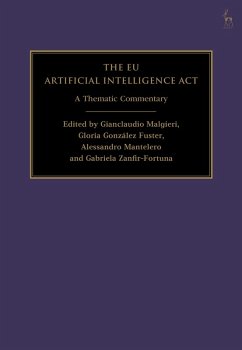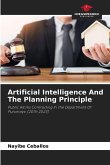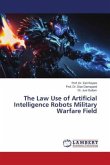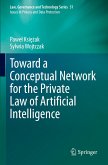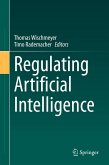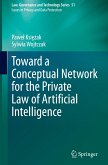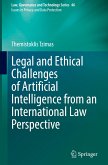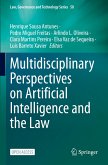The EU Artificial Intelligence Act
A Thematic Commentary
Herausgeber: Mantelero, Alessandro; Fuster, Gloria Gonzalez; Malgieri, Gianclaudio; Zanfir-Fortuna, Gabriela
Versandkostenfrei innerhalb Deutschlands
250,99 €
inkl. MwSt.
Versandkostenfrei*
Erscheint vorauss. 14. Mai 2026
Melden Sie sich
hier
hier
für den Produktalarm an, um über die Verfügbarkeit des Produkts informiert zu werden.

125 °P sammeln
The EU Artificial Intelligence Act
A Thematic Commentary
Herausgeber: Mantelero, Alessandro; Fuster, Gloria Gonzalez; Malgieri, Gianclaudio; Zanfir-Fortuna, Gabriela
- Gebundenes Buch
This thematic commentary analyses the core provisions and overarching themes of the EU Artificial Intelligence (AI) Act to provide readers with the information needed to understand, situate and implement this new piece of legislation in their practice. The book offers a rich variety of views on one of the most challenging legal innovations of EU law. It analyses individual provisions exhaustively, where their relevance and complexity require specific analysis to guide their implementation, and thematically, where beneficial for a broader view of some of the strategic axes of the Act.…mehr
Andere Kunden interessierten sich auch für
![Artificial Intelligence And The Planning Principle Artificial Intelligence And The Planning Principle]() Nayibe CeballosArtificial Intelligence And The Planning Principle29,99 €
Nayibe CeballosArtificial Intelligence And The Planning Principle29,99 €![The Law Use of Artificial Intelligence Robots Military Warfare Field The Law Use of Artificial Intelligence Robots Military Warfare Field]() Esti RoyaniThe Law Use of Artificial Intelligence Robots Military Warfare Field40,99 €
Esti RoyaniThe Law Use of Artificial Intelligence Robots Military Warfare Field40,99 €![Toward a Conceptual Network for the Private Law of Artificial Intelligence Toward a Conceptual Network for the Private Law of Artificial Intelligence]() Pawel KsiezakToward a Conceptual Network for the Private Law of Artificial Intelligence121,99 €
Pawel KsiezakToward a Conceptual Network for the Private Law of Artificial Intelligence121,99 €![Regulating Artificial Intelligence Regulating Artificial Intelligence]() Regulating Artificial Intelligence106,99 €
Regulating Artificial Intelligence106,99 €![Toward a Conceptual Network for the Private Law of Artificial Intelligence Toward a Conceptual Network for the Private Law of Artificial Intelligence]() Pawel KsiezakToward a Conceptual Network for the Private Law of Artificial Intelligence121,99 €
Pawel KsiezakToward a Conceptual Network for the Private Law of Artificial Intelligence121,99 €![Legal and Ethical Challenges of Artificial Intelligence from an International Law Perspective Legal and Ethical Challenges of Artificial Intelligence from an International Law Perspective]() Themistoklis TzimasLegal and Ethical Challenges of Artificial Intelligence from an International Law Perspective98,99 €
Themistoklis TzimasLegal and Ethical Challenges of Artificial Intelligence from an International Law Perspective98,99 €![Multidisciplinary Perspectives on Artificial Intelligence and the Law Multidisciplinary Perspectives on Artificial Intelligence and the Law]() Multidisciplinary Perspectives on Artificial Intelligence and the Law31,99 €
Multidisciplinary Perspectives on Artificial Intelligence and the Law31,99 €-
-
-
This thematic commentary analyses the core provisions and overarching themes of the EU Artificial Intelligence (AI) Act to provide readers with the information needed to understand, situate and implement this new piece of legislation in their practice. The book offers a rich variety of views on one of the most challenging legal innovations of EU law. It analyses individual provisions exhaustively, where their relevance and complexity require specific analysis to guide their implementation, and thematically, where beneficial for a broader view of some of the strategic axes of the Act. Importantly, the chapters unpack connections both within the various components of the EU AI Act itself, as well as with the other key instruments such as the Digital Services Act (DSA), the Digital Markets Act (DMA) and the General Data Protection Regulation (GDPR). The Thematic Commentary thus provides in-depth coverage of key aspects of the EU AI Act, including detailed reviews of rules on prohibited practices, high-risk AI systems, governance structures, measures to support innovation such as regulatory sandboxes, or codes of conduct. Written by a curated selection of authors that include renowned academics, global practitioners, and institutional experts involved in the drafting process, this Commentary is a key authoritative source bringing together many different voices. Whether for legal practitioners seeking insights into the practical implementation of the EU AI Act, scholars, regulators and policymakers who need to understand the theoretical and policy implications of the Act, or students looking for an advanced analysis of the EU AI Act in context, this Thematic Commentary is the guiding reference on AI regulation in the EU.
Produktdetails
- Produktdetails
- Verlag: Bloomsbury Publishing PLC
- Seitenzahl: 688
- Erscheinungstermin: 14. Mai 2026
- Englisch
- Abmessung: 244mm x 169mm
- ISBN-13: 9781509988600
- ISBN-10: 1509988602
- Artikelnr.: 75366980
- Herstellerkennzeichnung
- Libri GmbH
- Europaallee 1
- 36244 Bad Hersfeld
- gpsr@libri.de
- Verlag: Bloomsbury Publishing PLC
- Seitenzahl: 688
- Erscheinungstermin: 14. Mai 2026
- Englisch
- Abmessung: 244mm x 169mm
- ISBN-13: 9781509988600
- ISBN-10: 1509988602
- Artikelnr.: 75366980
- Herstellerkennzeichnung
- Libri GmbH
- Europaallee 1
- 36244 Bad Hersfeld
- gpsr@libri.de
Gianclaudio Malgieri is Associate Professor of Law and Technology at Leiden University, the Netherlands. Gloria González Fuster is Research Professor at Vrije Universiteit Brussel, Belgium. Alessandro Mantelero is Associate Professor of Law, Polytechnic University Tourin, Italy. Gabriela Zanfir-Fortuna is Vice President for Global Privacy, Future of Privacy Forum, USA.
Introduction
Gianclaudio Malgieri (Leiden University
the Netherlands)
Gloria González Fuster (Vrije Universiteit Brussel
Belgium)
Alessandro Mantelero (Polytechnic University Tourin
Italy)
and Gabriela Zanfir-Fortuna (Future of Privacy Forum) Part I: Key Issues 1. Why the EU AI Act: The Objectives of the Law
Frederik Zuiderveen Borgesius (Radboud University
the Netherlands) and Gianclaudio Malgieri (Leiden University
the Netherlands) 2. The Scope of the AI Act in the Light of the EU's Digital Strategy (Art 2)
Alessandro Mantelero (Politecnico di Torino
Italy) 3. Defining AI Regulation: Main Actors and Key Notions (Definitions) (Art 3)
Gabriela Zanfir-Fortuna (Future of Privacy Forum) 4. The Risk Framework in the AI Act and the Role of the EC (Article 6
7
Annex I
Annex III
Article 50
Art 9)
Laura Caroli (Center for Strategic and International Studies
USA) 5. The Mixed Nature of the AI Act: Product Safety and Fundamental Rights Regulation
Giovanni De Gregorio (Católica Global School of Law
Portugal) and Marco Almada (University of Luxembourg) Part II: Prohibited Practices 6. The Prohibitions Related to Human Vulnerabilities and Manipulation (Art 5.1.a
5.1.b)
Maria-Lucia Rebrean (Leiden University
the Netherlands)
Silvia De Conca (Vrije Universiteit Amsterdam) 7. The Prohibitions of Social Scoring (Art 5.1.c)
Nathan Genicot (Vrije Universiteit Brussel
Belgium) 8. Prohibition on Predictive Policing (Art. 5.1.d) and Facial Recognition (Art. 5.1.e)
Bart Custers (Leiden University
the Netherlands) 9. Prohibition on Emotion Recognition Systems in Education and in the Workplace (Art 5.1.f)
Andreas Hauselmann (Open Universiteit
the Netherlands) 10. The Prohibitions Related to Biometric Surveillance and their Exceptions (5.1.e
5.1.g.
5.1.h.
5.2)
Gavin Robinson (Leiden University
the Netherlands) Part III: High-Risk AI Systems 11. Classification of High-risk AI Systems and its Update (Art 6
7
50
71
Annex I
Annex III)
Giorgio Resta (Roma Tre University
Italy) and Cristina Frattone (Roma Tre University) 12. Obligations of Providers of High-Risk AI Systems (Art 8
Article 9
16
20
21
22)
Phil Lee (Digiphile
UK) 13. Deployers: Identification and Obligations (Art 26)
Phil Lee (Digiphile
UK) 14. Conformity Assessment
Quality and Risk Management Systems (Art 8
9
17
42
43
46)
Alessandro Mantelero (Politecnico di Torino
Italy) 15. The FRIA (Art 27)
Alessandro Mantelero (Politecnico di Torino
Italy) 16. Data and Data Governance (Art 10)
Margo Bernelin (Centre national de la recherche scientifique
France) and Michaël Van den Poel (EDHEC Business School
France) 17. Accountability and Transparency (Art 11
12
13
18
19
50)
Gabe Maldoff (Goodwin
USA) 18. Human Oversight (Art 14)
Melanie Fink (Leiden University
the Netherlands) 19. Accuracy
Robustness
and Cybersecurity (Art 15)
Giuseppe Vaciago (Politecnico di Torino
Italy) 20. Identification and Obligations of Importers
Distributors
and Responsibilities Along the AI Value Chain (Art 23
24
25)
Bart Schermer (Leiden University
the Netherlands) 21. Standards and Common Specification (arts 40
41)
Irene Kamara (Tilburg University
the Netherlands) 22. Certificates
Declaration of Conformity
CE Marking
and Registration (Art 28-39
44
45
46
47
48
49)
Max von Grafenstein
Valentin Rupp (University of the Arts in Berlin
Germany) Part IV: GPAI and General-Purpose AI Models 23 and 24. Transparency and Obligations for General Purpose AI (Art 53
54
56)
Michael Veale (University College London
UK) and Joao Quintals (University of Amsterdam
the Netherlands) 25. General Purpose AI Models with Systemic Risks. Classification and Specific Obligations (Art 51
52
55)
Connor Dunlop (Ada Lovelace Institute
UK) Part V: Measures in Support of Innovation 26. AI Regulatory Sandboxes (Art 57-61)
Thiago Guimaraes Moraes (Brazilian Data Protection Authority) 27. SMEs and Derogation (Art 62
63)
Vincenzo Tiani (Future of Privacy Forum
Belgium) Part VI: Governance 28. EU Level Governance (AI Office
AI Board
Advisory Forum
Scientific Panel) (Art 64 - 69)
Claudio Novelli (Yale University
USA) 29. National Level Governance (National Competent Authorities) and Notification Procedures (incl. Arts 30-31 and 28-39) (Art 70)
Joanna Mazur (University of Warsaw
Poland) Part VII: Monitoring and Enforcement 30. Post-market Monitoring (Art 72
73)
Brenda Leong (ZwillGen PLLC
USA) 31. Enforcement (Art 74 - 84
88 - 94)
Luca Tosoni (Schjødt
Norway) 32. The Right to Explanation (Art 86)
Margot Kaminski (University of Colorado Law School
USA) and Gianclaudio Malgieri (Leiden University
the Netherlands) 33. Remedies and Penalties (Art 85
87
99 - 101)
Maria Magierska (Maastricht University
the Netherlands) Part VIII: Codes of Conducts
Guidelines and AI Literacy 34. Codes of Conduct and EC Guidelines (Art 56
95-98)
Denise Amram (Scuola Superiore Sant'Anna
Italy)
Roberta Romano (Scuola Superiore Sant'Anna
Italy) 35. AI Literacy (Art 4)
Tommaso Fia (University College London) Part IX: The AI Act Interactions with the Digital Rulebook 36. Consistency and Interplay with the GDPR
Gloria González Fuster (Vrije Universiteit Brussel
Belgium) 37. Consistency and Interplay with the DSA
Gianclaudio Malgieri (Leiden University) 38. The AI Act and liability issues
Gianmarco Gori (Vrije Universiteit Brussel
Belgium) 39. The Interplay between the AIA and the DMA
Muhammed Demircan
Osman Gazi Gucluturk
Heidi Warm and Florentien Maes (DLA Piper)
Gianclaudio Malgieri (Leiden University
the Netherlands)
Gloria González Fuster (Vrije Universiteit Brussel
Belgium)
Alessandro Mantelero (Polytechnic University Tourin
Italy)
and Gabriela Zanfir-Fortuna (Future of Privacy Forum) Part I: Key Issues 1. Why the EU AI Act: The Objectives of the Law
Frederik Zuiderveen Borgesius (Radboud University
the Netherlands) and Gianclaudio Malgieri (Leiden University
the Netherlands) 2. The Scope of the AI Act in the Light of the EU's Digital Strategy (Art 2)
Alessandro Mantelero (Politecnico di Torino
Italy) 3. Defining AI Regulation: Main Actors and Key Notions (Definitions) (Art 3)
Gabriela Zanfir-Fortuna (Future of Privacy Forum) 4. The Risk Framework in the AI Act and the Role of the EC (Article 6
7
Annex I
Annex III
Article 50
Art 9)
Laura Caroli (Center for Strategic and International Studies
USA) 5. The Mixed Nature of the AI Act: Product Safety and Fundamental Rights Regulation
Giovanni De Gregorio (Católica Global School of Law
Portugal) and Marco Almada (University of Luxembourg) Part II: Prohibited Practices 6. The Prohibitions Related to Human Vulnerabilities and Manipulation (Art 5.1.a
5.1.b)
Maria-Lucia Rebrean (Leiden University
the Netherlands)
Silvia De Conca (Vrije Universiteit Amsterdam) 7. The Prohibitions of Social Scoring (Art 5.1.c)
Nathan Genicot (Vrije Universiteit Brussel
Belgium) 8. Prohibition on Predictive Policing (Art. 5.1.d) and Facial Recognition (Art. 5.1.e)
Bart Custers (Leiden University
the Netherlands) 9. Prohibition on Emotion Recognition Systems in Education and in the Workplace (Art 5.1.f)
Andreas Hauselmann (Open Universiteit
the Netherlands) 10. The Prohibitions Related to Biometric Surveillance and their Exceptions (5.1.e
5.1.g.
5.1.h.
5.2)
Gavin Robinson (Leiden University
the Netherlands) Part III: High-Risk AI Systems 11. Classification of High-risk AI Systems and its Update (Art 6
7
50
71
Annex I
Annex III)
Giorgio Resta (Roma Tre University
Italy) and Cristina Frattone (Roma Tre University) 12. Obligations of Providers of High-Risk AI Systems (Art 8
Article 9
16
20
21
22)
Phil Lee (Digiphile
UK) 13. Deployers: Identification and Obligations (Art 26)
Phil Lee (Digiphile
UK) 14. Conformity Assessment
Quality and Risk Management Systems (Art 8
9
17
42
43
46)
Alessandro Mantelero (Politecnico di Torino
Italy) 15. The FRIA (Art 27)
Alessandro Mantelero (Politecnico di Torino
Italy) 16. Data and Data Governance (Art 10)
Margo Bernelin (Centre national de la recherche scientifique
France) and Michaël Van den Poel (EDHEC Business School
France) 17. Accountability and Transparency (Art 11
12
13
18
19
50)
Gabe Maldoff (Goodwin
USA) 18. Human Oversight (Art 14)
Melanie Fink (Leiden University
the Netherlands) 19. Accuracy
Robustness
and Cybersecurity (Art 15)
Giuseppe Vaciago (Politecnico di Torino
Italy) 20. Identification and Obligations of Importers
Distributors
and Responsibilities Along the AI Value Chain (Art 23
24
25)
Bart Schermer (Leiden University
the Netherlands) 21. Standards and Common Specification (arts 40
41)
Irene Kamara (Tilburg University
the Netherlands) 22. Certificates
Declaration of Conformity
CE Marking
and Registration (Art 28-39
44
45
46
47
48
49)
Max von Grafenstein
Valentin Rupp (University of the Arts in Berlin
Germany) Part IV: GPAI and General-Purpose AI Models 23 and 24. Transparency and Obligations for General Purpose AI (Art 53
54
56)
Michael Veale (University College London
UK) and Joao Quintals (University of Amsterdam
the Netherlands) 25. General Purpose AI Models with Systemic Risks. Classification and Specific Obligations (Art 51
52
55)
Connor Dunlop (Ada Lovelace Institute
UK) Part V: Measures in Support of Innovation 26. AI Regulatory Sandboxes (Art 57-61)
Thiago Guimaraes Moraes (Brazilian Data Protection Authority) 27. SMEs and Derogation (Art 62
63)
Vincenzo Tiani (Future of Privacy Forum
Belgium) Part VI: Governance 28. EU Level Governance (AI Office
AI Board
Advisory Forum
Scientific Panel) (Art 64 - 69)
Claudio Novelli (Yale University
USA) 29. National Level Governance (National Competent Authorities) and Notification Procedures (incl. Arts 30-31 and 28-39) (Art 70)
Joanna Mazur (University of Warsaw
Poland) Part VII: Monitoring and Enforcement 30. Post-market Monitoring (Art 72
73)
Brenda Leong (ZwillGen PLLC
USA) 31. Enforcement (Art 74 - 84
88 - 94)
Luca Tosoni (Schjødt
Norway) 32. The Right to Explanation (Art 86)
Margot Kaminski (University of Colorado Law School
USA) and Gianclaudio Malgieri (Leiden University
the Netherlands) 33. Remedies and Penalties (Art 85
87
99 - 101)
Maria Magierska (Maastricht University
the Netherlands) Part VIII: Codes of Conducts
Guidelines and AI Literacy 34. Codes of Conduct and EC Guidelines (Art 56
95-98)
Denise Amram (Scuola Superiore Sant'Anna
Italy)
Roberta Romano (Scuola Superiore Sant'Anna
Italy) 35. AI Literacy (Art 4)
Tommaso Fia (University College London) Part IX: The AI Act Interactions with the Digital Rulebook 36. Consistency and Interplay with the GDPR
Gloria González Fuster (Vrije Universiteit Brussel
Belgium) 37. Consistency and Interplay with the DSA
Gianclaudio Malgieri (Leiden University) 38. The AI Act and liability issues
Gianmarco Gori (Vrije Universiteit Brussel
Belgium) 39. The Interplay between the AIA and the DMA
Muhammed Demircan
Osman Gazi Gucluturk
Heidi Warm and Florentien Maes (DLA Piper)
Introduction
Gianclaudio Malgieri (Leiden University
the Netherlands)
Gloria González Fuster (Vrije Universiteit Brussel
Belgium)
Alessandro Mantelero (Polytechnic University Tourin
Italy)
and Gabriela Zanfir-Fortuna (Future of Privacy Forum) Part I: Key Issues 1. Why the EU AI Act: The Objectives of the Law
Frederik Zuiderveen Borgesius (Radboud University
the Netherlands) and Gianclaudio Malgieri (Leiden University
the Netherlands) 2. The Scope of the AI Act in the Light of the EU's Digital Strategy (Art 2)
Alessandro Mantelero (Politecnico di Torino
Italy) 3. Defining AI Regulation: Main Actors and Key Notions (Definitions) (Art 3)
Gabriela Zanfir-Fortuna (Future of Privacy Forum) 4. The Risk Framework in the AI Act and the Role of the EC (Article 6
7
Annex I
Annex III
Article 50
Art 9)
Laura Caroli (Center for Strategic and International Studies
USA) 5. The Mixed Nature of the AI Act: Product Safety and Fundamental Rights Regulation
Giovanni De Gregorio (Católica Global School of Law
Portugal) and Marco Almada (University of Luxembourg) Part II: Prohibited Practices 6. The Prohibitions Related to Human Vulnerabilities and Manipulation (Art 5.1.a
5.1.b)
Maria-Lucia Rebrean (Leiden University
the Netherlands)
Silvia De Conca (Vrije Universiteit Amsterdam) 7. The Prohibitions of Social Scoring (Art 5.1.c)
Nathan Genicot (Vrije Universiteit Brussel
Belgium) 8. Prohibition on Predictive Policing (Art. 5.1.d) and Facial Recognition (Art. 5.1.e)
Bart Custers (Leiden University
the Netherlands) 9. Prohibition on Emotion Recognition Systems in Education and in the Workplace (Art 5.1.f)
Andreas Hauselmann (Open Universiteit
the Netherlands) 10. The Prohibitions Related to Biometric Surveillance and their Exceptions (5.1.e
5.1.g.
5.1.h.
5.2)
Gavin Robinson (Leiden University
the Netherlands) Part III: High-Risk AI Systems 11. Classification of High-risk AI Systems and its Update (Art 6
7
50
71
Annex I
Annex III)
Giorgio Resta (Roma Tre University
Italy) and Cristina Frattone (Roma Tre University) 12. Obligations of Providers of High-Risk AI Systems (Art 8
Article 9
16
20
21
22)
Phil Lee (Digiphile
UK) 13. Deployers: Identification and Obligations (Art 26)
Phil Lee (Digiphile
UK) 14. Conformity Assessment
Quality and Risk Management Systems (Art 8
9
17
42
43
46)
Alessandro Mantelero (Politecnico di Torino
Italy) 15. The FRIA (Art 27)
Alessandro Mantelero (Politecnico di Torino
Italy) 16. Data and Data Governance (Art 10)
Margo Bernelin (Centre national de la recherche scientifique
France) and Michaël Van den Poel (EDHEC Business School
France) 17. Accountability and Transparency (Art 11
12
13
18
19
50)
Gabe Maldoff (Goodwin
USA) 18. Human Oversight (Art 14)
Melanie Fink (Leiden University
the Netherlands) 19. Accuracy
Robustness
and Cybersecurity (Art 15)
Giuseppe Vaciago (Politecnico di Torino
Italy) 20. Identification and Obligations of Importers
Distributors
and Responsibilities Along the AI Value Chain (Art 23
24
25)
Bart Schermer (Leiden University
the Netherlands) 21. Standards and Common Specification (arts 40
41)
Irene Kamara (Tilburg University
the Netherlands) 22. Certificates
Declaration of Conformity
CE Marking
and Registration (Art 28-39
44
45
46
47
48
49)
Max von Grafenstein
Valentin Rupp (University of the Arts in Berlin
Germany) Part IV: GPAI and General-Purpose AI Models 23 and 24. Transparency and Obligations for General Purpose AI (Art 53
54
56)
Michael Veale (University College London
UK) and Joao Quintals (University of Amsterdam
the Netherlands) 25. General Purpose AI Models with Systemic Risks. Classification and Specific Obligations (Art 51
52
55)
Connor Dunlop (Ada Lovelace Institute
UK) Part V: Measures in Support of Innovation 26. AI Regulatory Sandboxes (Art 57-61)
Thiago Guimaraes Moraes (Brazilian Data Protection Authority) 27. SMEs and Derogation (Art 62
63)
Vincenzo Tiani (Future of Privacy Forum
Belgium) Part VI: Governance 28. EU Level Governance (AI Office
AI Board
Advisory Forum
Scientific Panel) (Art 64 - 69)
Claudio Novelli (Yale University
USA) 29. National Level Governance (National Competent Authorities) and Notification Procedures (incl. Arts 30-31 and 28-39) (Art 70)
Joanna Mazur (University of Warsaw
Poland) Part VII: Monitoring and Enforcement 30. Post-market Monitoring (Art 72
73)
Brenda Leong (ZwillGen PLLC
USA) 31. Enforcement (Art 74 - 84
88 - 94)
Luca Tosoni (Schjødt
Norway) 32. The Right to Explanation (Art 86)
Margot Kaminski (University of Colorado Law School
USA) and Gianclaudio Malgieri (Leiden University
the Netherlands) 33. Remedies and Penalties (Art 85
87
99 - 101)
Maria Magierska (Maastricht University
the Netherlands) Part VIII: Codes of Conducts
Guidelines and AI Literacy 34. Codes of Conduct and EC Guidelines (Art 56
95-98)
Denise Amram (Scuola Superiore Sant'Anna
Italy)
Roberta Romano (Scuola Superiore Sant'Anna
Italy) 35. AI Literacy (Art 4)
Tommaso Fia (University College London) Part IX: The AI Act Interactions with the Digital Rulebook 36. Consistency and Interplay with the GDPR
Gloria González Fuster (Vrije Universiteit Brussel
Belgium) 37. Consistency and Interplay with the DSA
Gianclaudio Malgieri (Leiden University) 38. The AI Act and liability issues
Gianmarco Gori (Vrije Universiteit Brussel
Belgium) 39. The Interplay between the AIA and the DMA
Muhammed Demircan
Osman Gazi Gucluturk
Heidi Warm and Florentien Maes (DLA Piper)
Gianclaudio Malgieri (Leiden University
the Netherlands)
Gloria González Fuster (Vrije Universiteit Brussel
Belgium)
Alessandro Mantelero (Polytechnic University Tourin
Italy)
and Gabriela Zanfir-Fortuna (Future of Privacy Forum) Part I: Key Issues 1. Why the EU AI Act: The Objectives of the Law
Frederik Zuiderveen Borgesius (Radboud University
the Netherlands) and Gianclaudio Malgieri (Leiden University
the Netherlands) 2. The Scope of the AI Act in the Light of the EU's Digital Strategy (Art 2)
Alessandro Mantelero (Politecnico di Torino
Italy) 3. Defining AI Regulation: Main Actors and Key Notions (Definitions) (Art 3)
Gabriela Zanfir-Fortuna (Future of Privacy Forum) 4. The Risk Framework in the AI Act and the Role of the EC (Article 6
7
Annex I
Annex III
Article 50
Art 9)
Laura Caroli (Center for Strategic and International Studies
USA) 5. The Mixed Nature of the AI Act: Product Safety and Fundamental Rights Regulation
Giovanni De Gregorio (Católica Global School of Law
Portugal) and Marco Almada (University of Luxembourg) Part II: Prohibited Practices 6. The Prohibitions Related to Human Vulnerabilities and Manipulation (Art 5.1.a
5.1.b)
Maria-Lucia Rebrean (Leiden University
the Netherlands)
Silvia De Conca (Vrije Universiteit Amsterdam) 7. The Prohibitions of Social Scoring (Art 5.1.c)
Nathan Genicot (Vrije Universiteit Brussel
Belgium) 8. Prohibition on Predictive Policing (Art. 5.1.d) and Facial Recognition (Art. 5.1.e)
Bart Custers (Leiden University
the Netherlands) 9. Prohibition on Emotion Recognition Systems in Education and in the Workplace (Art 5.1.f)
Andreas Hauselmann (Open Universiteit
the Netherlands) 10. The Prohibitions Related to Biometric Surveillance and their Exceptions (5.1.e
5.1.g.
5.1.h.
5.2)
Gavin Robinson (Leiden University
the Netherlands) Part III: High-Risk AI Systems 11. Classification of High-risk AI Systems and its Update (Art 6
7
50
71
Annex I
Annex III)
Giorgio Resta (Roma Tre University
Italy) and Cristina Frattone (Roma Tre University) 12. Obligations of Providers of High-Risk AI Systems (Art 8
Article 9
16
20
21
22)
Phil Lee (Digiphile
UK) 13. Deployers: Identification and Obligations (Art 26)
Phil Lee (Digiphile
UK) 14. Conformity Assessment
Quality and Risk Management Systems (Art 8
9
17
42
43
46)
Alessandro Mantelero (Politecnico di Torino
Italy) 15. The FRIA (Art 27)
Alessandro Mantelero (Politecnico di Torino
Italy) 16. Data and Data Governance (Art 10)
Margo Bernelin (Centre national de la recherche scientifique
France) and Michaël Van den Poel (EDHEC Business School
France) 17. Accountability and Transparency (Art 11
12
13
18
19
50)
Gabe Maldoff (Goodwin
USA) 18. Human Oversight (Art 14)
Melanie Fink (Leiden University
the Netherlands) 19. Accuracy
Robustness
and Cybersecurity (Art 15)
Giuseppe Vaciago (Politecnico di Torino
Italy) 20. Identification and Obligations of Importers
Distributors
and Responsibilities Along the AI Value Chain (Art 23
24
25)
Bart Schermer (Leiden University
the Netherlands) 21. Standards and Common Specification (arts 40
41)
Irene Kamara (Tilburg University
the Netherlands) 22. Certificates
Declaration of Conformity
CE Marking
and Registration (Art 28-39
44
45
46
47
48
49)
Max von Grafenstein
Valentin Rupp (University of the Arts in Berlin
Germany) Part IV: GPAI and General-Purpose AI Models 23 and 24. Transparency and Obligations for General Purpose AI (Art 53
54
56)
Michael Veale (University College London
UK) and Joao Quintals (University of Amsterdam
the Netherlands) 25. General Purpose AI Models with Systemic Risks. Classification and Specific Obligations (Art 51
52
55)
Connor Dunlop (Ada Lovelace Institute
UK) Part V: Measures in Support of Innovation 26. AI Regulatory Sandboxes (Art 57-61)
Thiago Guimaraes Moraes (Brazilian Data Protection Authority) 27. SMEs and Derogation (Art 62
63)
Vincenzo Tiani (Future of Privacy Forum
Belgium) Part VI: Governance 28. EU Level Governance (AI Office
AI Board
Advisory Forum
Scientific Panel) (Art 64 - 69)
Claudio Novelli (Yale University
USA) 29. National Level Governance (National Competent Authorities) and Notification Procedures (incl. Arts 30-31 and 28-39) (Art 70)
Joanna Mazur (University of Warsaw
Poland) Part VII: Monitoring and Enforcement 30. Post-market Monitoring (Art 72
73)
Brenda Leong (ZwillGen PLLC
USA) 31. Enforcement (Art 74 - 84
88 - 94)
Luca Tosoni (Schjødt
Norway) 32. The Right to Explanation (Art 86)
Margot Kaminski (University of Colorado Law School
USA) and Gianclaudio Malgieri (Leiden University
the Netherlands) 33. Remedies and Penalties (Art 85
87
99 - 101)
Maria Magierska (Maastricht University
the Netherlands) Part VIII: Codes of Conducts
Guidelines and AI Literacy 34. Codes of Conduct and EC Guidelines (Art 56
95-98)
Denise Amram (Scuola Superiore Sant'Anna
Italy)
Roberta Romano (Scuola Superiore Sant'Anna
Italy) 35. AI Literacy (Art 4)
Tommaso Fia (University College London) Part IX: The AI Act Interactions with the Digital Rulebook 36. Consistency and Interplay with the GDPR
Gloria González Fuster (Vrije Universiteit Brussel
Belgium) 37. Consistency and Interplay with the DSA
Gianclaudio Malgieri (Leiden University) 38. The AI Act and liability issues
Gianmarco Gori (Vrije Universiteit Brussel
Belgium) 39. The Interplay between the AIA and the DMA
Muhammed Demircan
Osman Gazi Gucluturk
Heidi Warm and Florentien Maes (DLA Piper)
